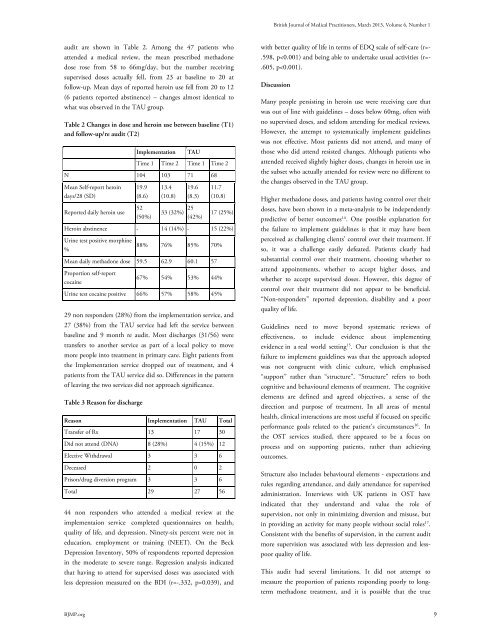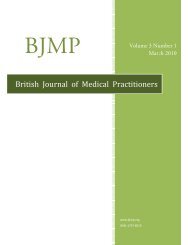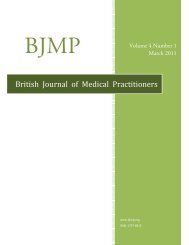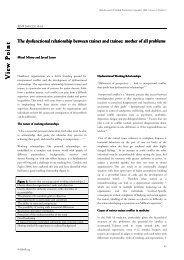R esearch A rticle - British Journal of Medical Practitioners
R esearch A rticle - British Journal of Medical Practitioners
R esearch A rticle - British Journal of Medical Practitioners
You also want an ePaper? Increase the reach of your titles
YUMPU automatically turns print PDFs into web optimized ePapers that Google loves.
<strong>British</strong> <strong>Journal</strong> <strong>of</strong> <strong>Medical</strong> <strong>Practitioners</strong>, March 2013, Volume 6, Number 1<br />
audit are shown in Table 2. Among the 47 patients who<br />
attended a medical review, the mean prescribed methadone<br />
dose rose from 58 to 66mg/day, but the number receiving<br />
supervised doses actually fell, from 23 at baseline to 20 at<br />
follow-up. Mean days <strong>of</strong> reported heroin use fell from 20 to 12<br />
(6 patients reported abstinence) – changes almost identical to<br />
what was observed in the TAU group.<br />
Table 2 Changes in dose and heroin use between baseline (T1)<br />
and follow-up/re audit (T2)<br />
Implementation<br />
TAU<br />
Time 1 Time 2 Time 1 Time 2<br />
N 104 103 71 68<br />
Mean Self-report heroin<br />
days/28 (SD)<br />
Reported daily heroin use<br />
19.9<br />
(8.6)<br />
52<br />
(50%)<br />
13.4<br />
(10.8)<br />
19.6<br />
(8.3)<br />
33 (32%) 25<br />
(42%)<br />
11.7<br />
(10.8)<br />
17 (25%)<br />
Heroin abstinence - 14 (14%) - 15 (22%)<br />
Urine test positive morphine<br />
%<br />
88% 76% 85% 70%<br />
Mean daily methadone dose 59.5 62.9 60.1 57<br />
Proportion self-report<br />
cocaine<br />
67% 54% 53% 44%<br />
Urine test cocaine positive 66% 57% 58% 45%<br />
29 non responders (28%) from the implementation service, and<br />
27 (38%) from the TAU service had left the service between<br />
baseline and 9 month re audit. Most discharges (31/56) were<br />
transfers to another service as part <strong>of</strong> a local policy to move<br />
more people into treatment in primary care. Eight patients from<br />
the Implementation service dropped out <strong>of</strong> treatment, and 4<br />
patients from the TAU service did so. Differences in the pattern<br />
<strong>of</strong> leaving the two services did not approach significance.<br />
Table 3 Reason for discharge<br />
Reason Implementation TAU Total<br />
Transfer <strong>of</strong> Rx 13 17 30<br />
Did not attend (DNA) 8 (28%) 4 (15%) 12<br />
Elective Withdrawal 3 3 6<br />
Deceased 2 0 2<br />
Prison/drug diversion program 3 3 6<br />
Total 29 27 56<br />
44 non responders who attended a medical review at the<br />
implementaion service completed questionnaires on health,<br />
quality <strong>of</strong> life, and depression. Ninety-six percent were not in<br />
education, employment or training (NEET). On the Beck<br />
Depression Inventory, 50% <strong>of</strong> respondents reported depression<br />
in the moderate to severe range. Regression analysis indicated<br />
that having to attend for supervised doses was associated with<br />
less depression measured on the BDI (r=-.332, p=0.039), and<br />
with better quality <strong>of</strong> life in terms <strong>of</strong> EDQ scale <strong>of</strong> self-care (r=-<br />
.598, p







